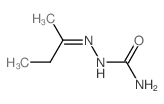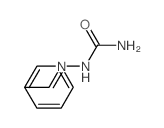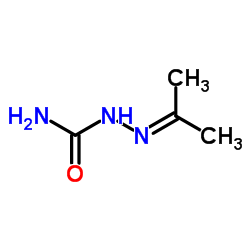Nitrofurazone

Nitrofurazone structure
|
Common Name | Nitrofurazone | ||
|---|---|---|---|---|
| CAS Number | 59-87-0 | Molecular Weight | 198.136 | |
| Density | 1.7±0.1 g/cm3 | Boiling Point | 236-240ºC | |
| Molecular Formula | C6H6N4O4 | Melting Point | 242-244 °C(lit.) | |
| MSDS | Chinese USA | Flash Point | 2 °C | |
| Symbol |

GHS07 |
Signal Word | Warning | |
Use of NitrofurazoneNitrofural is a bactericidal compound used as an antibiotic most commonly in the form of ointments.Target: AntibacterialNitrofurazone, a nitroaromatic drug, is a broad spectrum antibiotic which has until now been considered as activated in bacteria by nitroreductases. Its use in medicine has become less frequent as safer and more effective products have become available, and it has been discontinued in the US.Nitrofurazone (NF) and its derivative, hydroxymethylnitrofurazone (NFOH), have presented antichagasic activity. In vitro cruzain inhibition tests were performed for both compounds, and the 50% inhibitory concentration (IC50) for NF and NFOH presented values of 22.83 ± 1.2 μM and 10.55 ± 0.81 μM, respectively. AM1 semi-empirical molecular modeling studies were performed to understand the activity of the compounds, corroborating the observed cruzain inhibitory activity. |
| Name | nitrofurazone |
|---|---|
| Synonym | More Synonyms |
| Description | Nitrofural is a bactericidal compound used as an antibiotic most commonly in the form of ointments.Target: AntibacterialNitrofurazone, a nitroaromatic drug, is a broad spectrum antibiotic which has until now been considered as activated in bacteria by nitroreductases. Its use in medicine has become less frequent as safer and more effective products have become available, and it has been discontinued in the US.Nitrofurazone (NF) and its derivative, hydroxymethylnitrofurazone (NFOH), have presented antichagasic activity. In vitro cruzain inhibition tests were performed for both compounds, and the 50% inhibitory concentration (IC50) for NF and NFOH presented values of 22.83 ± 1.2 μM and 10.55 ± 0.81 μM, respectively. AM1 semi-empirical molecular modeling studies were performed to understand the activity of the compounds, corroborating the observed cruzain inhibitory activity. |
|---|---|
| Related Catalog | |
| References |
| Density | 1.7±0.1 g/cm3 |
|---|---|
| Boiling Point | 236-240ºC |
| Melting Point | 242-244 °C(lit.) |
| Molecular Formula | C6H6N4O4 |
| Molecular Weight | 198.136 |
| Flash Point | 2 °C |
| Exact Mass | 198.038910 |
| PSA | 126.44000 |
| LogP | -0.36 |
| Index of Refraction | 1.674 |
| Water Solubility | <0.1 g/100 mL at 19 ºC |
CHEMICAL IDENTIFICATION
HEALTH HAZARD DATAACUTE TOXICITY DATA
MUTATION DATA
|
| Symbol |

GHS07 |
|---|---|
| Signal Word | Warning |
| Hazard Statements | H302-H317 |
| Precautionary Statements | P280 |
| Personal Protective Equipment | Eyeshields;Faceshields;full-face respirator (US);Gloves;multi-purpose combination respirator cartridge (US);type ABEK (EN14387) respirator filter |
| Hazard Codes | Xn:Harmful; |
| Risk Phrases | R22 |
| Safety Phrases | S36-S36/37-S26 |
| RIDADR | 3249 |
| WGK Germany | 3 |
| RTECS | LT7700000 |
| Packaging Group | III |
| Hazard Class | 6.1(b) |
| HS Code | 2934999090 |
| HS Code | 2934999090 |
|---|---|
| Summary | 2934999090. other heterocyclic compounds. VAT:17.0%. Tax rebate rate:13.0%. . MFN tariff:6.5%. General tariff:20.0% |
|
Purification and characterization of the Staphylococcus aureus bacillithiol transferase BstA.
Biochim. Biophys. Acta 1840(9) , 2851-61, (2014) Gram-positive bacteria in the phylum Firmicutes synthesize the low molecular weight thiol bacillithiol rather than glutathione or mycothiol. The bacillithiol transferase YfiT from Bacillus subtilis wa... |
|
|
Characterization of the genotoxic properties of nitrofurans: nitrofurazone and furazolidone.
Acta Biochim. Pol. 41(1) , 1-5, (1994)
|
|
|
Nitrofural (nitrofurazone).
IARC Monogr. Eval. Carcinog. Risks Hum. 50 , 195-209, (1990)
|
| Nefco |
| 5-nitro-2-furaldehyde semicarbazone |
| 5-nitrofuran-2-carbaldehyde semicarbazone |
| NFZ |
| (2E)-2-[(5-Nitro-2-furyl)methylene]hydrazinecarboxamide |
| Nitrofural |
| Chixin |
| NF-7 |
| 5-nitro-furfural semicarbazone |
| Mammex |
| U-6421 |
| 5-nitro-2-furfurylidenesemicarbazone |
| acutol |
| Nitrofurazone |
| 5-nitro-furan-2-carbaldehyde semicarbazone |
| (5-nitro-2-furfurylideneamino)urea |
| Hydrazinecarboxamide, 2-[(5-nitro-2-furanyl)methylene]-, (2E)- |
| 2-Furaldehyde, 5-nitro-, semicarbazone |
| 5-Nitro-2-furfuraldehyde semicarbazone |
| Amifur |
| NFS |
| MFCD00003225 |
| Furacilin |
| EINECS 200-443-1 |
 CAS#:698-63-5
CAS#:698-63-5 CAS#:563-41-7
CAS#:563-41-7 CAS#:92-55-7
CAS#:92-55-7 CAS#:624-46-4
CAS#:624-46-4 CAS#:1574-10-3
CAS#:1574-10-3 CAS#:110-20-3
CAS#:110-20-3
